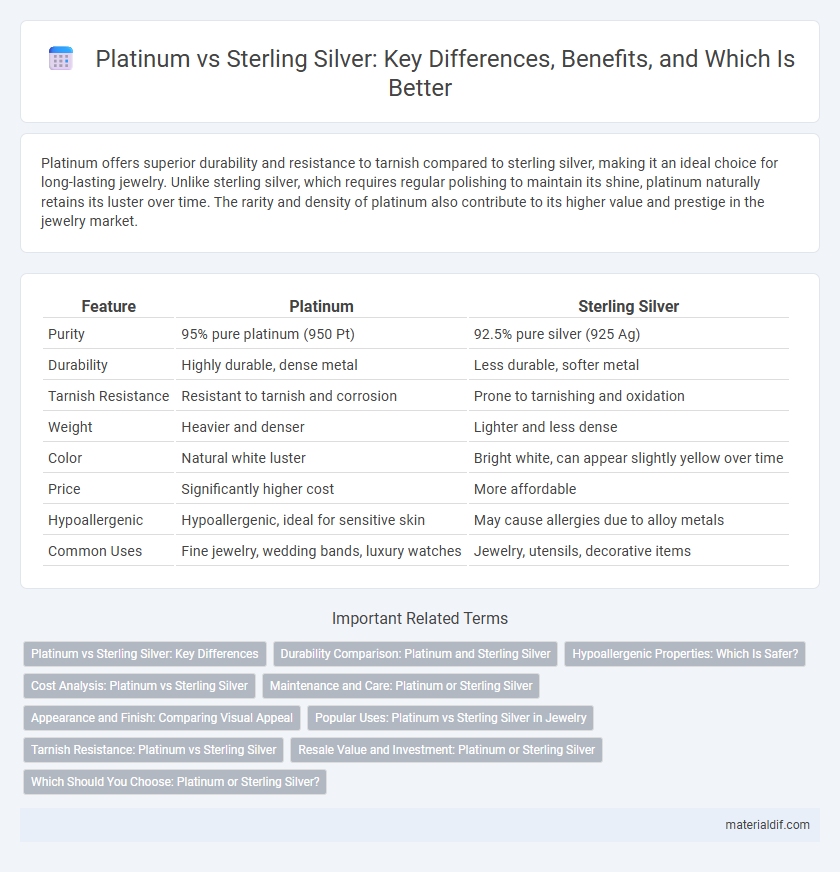Platinum offers superior durability and resistance to tarnish compared to sterling silver, making it an ideal choice for long-lasting jewelry. Unlike sterling silver, which requires regular polishing to maintain its shine, platinum naturally retains its luster over time. The rarity and density of platinum also contribute to its higher value and prestige in the jewelry market.
Table of Comparison
| Feature | Platinum | Sterling Silver |
|---|---|---|
| Purity | 95% pure platinum (950 Pt) | 92.5% pure silver (925 Ag) |
| Durability | Highly durable, dense metal | Less durable, softer metal |
| Tarnish Resistance | Resistant to tarnish and corrosion | Prone to tarnishing and oxidation |
| Weight | Heavier and denser | Lighter and less dense |
| Color | Natural white luster | Bright white, can appear slightly yellow over time |
| Price | Significantly higher cost | More affordable |
| Hypoallergenic | Hypoallergenic, ideal for sensitive skin | May cause allergies due to alloy metals |
| Common Uses | Fine jewelry, wedding bands, luxury watches | Jewelry, utensils, decorative items |
Platinum vs Sterling Silver: Key Differences
Platinum and sterling silver differ significantly in durability, with platinum offering greater resistance to tarnish and corrosion, making it ideal for long-lasting jewelry. Platinum is naturally hypoallergenic, whereas sterling silver can cause skin irritations due to its copper content. The density and weight of platinum make it heavier and more valuable per gram compared to the lighter, less expensive sterling silver.
Durability Comparison: Platinum and Sterling Silver
Platinum offers superior durability compared to sterling silver due to its higher density and resistance to wear, making it ideal for everyday jewelry that withstands scratches and tarnishing. Sterling silver, being softer and more prone to oxidation, requires regular maintenance to maintain its appearance, limiting its long-term resilience. In terms of longevity, platinum's robust molecular structure ensures it retains shape and luster far longer than sterling silver, which can bend or corrode over time.
Hypoallergenic Properties: Which Is Safer?
Platinum exhibits superior hypoallergenic properties compared to sterling silver due to its pure composition and resistance to common allergens like nickel. Sterling silver often contains trace amounts of nickel or other metals that can trigger allergic reactions in sensitive individuals. For those with metal sensitivities, platinum is a safer choice, minimizing the risk of skin irritation or allergic dermatitis.
Cost Analysis: Platinum vs Sterling Silver
Platinum typically costs between $30 to $50 per gram, significantly higher than sterling silver, which ranges from $0.70 to $1.50 per gram, reflecting platinum's rarity and durability. The price difference impacts overall jewelry cost, with platinum pieces often three to five times more expensive than sterling silver equivalents. Long-term value favors platinum due to its resistance to tarnish and wear, reducing maintenance and replacement expenses compared to sterling silver.
Maintenance and Care: Platinum or Sterling Silver
Platinum requires less frequent polishing and is highly resistant to tarnish, making it easier to maintain compared to sterling silver, which tarnishes more quickly and demands regular cleaning to preserve its shine. Both metals benefit from avoiding exposure to harsh chemicals and storing them properly to minimize scratches. Professional cleaning for platinum is recommended once or twice a year, while sterling silver may need more frequent attention to keep its bright appearance.
Appearance and Finish: Comparing Visual Appeal
Platinum exhibits a naturally white, lustrous sheen that resists tarnish and maintains its brightness over time, making it ideal for a durable, elegant finish. Sterling silver offers a bright, reflective surface but is prone to oxidation and tarnish, requiring regular polishing to preserve its shine. The dense, heavy feel of platinum enhances its luxurious appearance, while sterling silver's lighter weight can impact the perception of quality and finish.
Popular Uses: Platinum vs Sterling Silver in Jewelry
Platinum is prized in fine jewelry for its durability, natural white sheen, and hypoallergenic properties, making it ideal for engagement rings and luxury pieces that require long-lasting elegance. Sterling silver, favored for its affordability and versatility, is commonly used in fashion jewelry, everyday wear, and intricate designs due to its malleability. While platinum is a premium choice for heirloom-quality items, sterling silver offers accessible options for trendy and casual jewelry collections.
Tarnish Resistance: Platinum vs Sterling Silver
Platinum offers superior tarnish resistance compared to sterling silver due to its inert nature and high resistance to oxidation and corrosion. Sterling silver often tarnishes over time because it contains copper, which reacts with sulfur and moisture in the air, leading to a dull, dark patina. Choosing platinum ensures long-lasting shine and minimal maintenance, making it ideal for jewelry that retains its luster without frequent polishing.
Resale Value and Investment: Platinum or Sterling Silver
Platinum holds significantly higher resale value and investment potential compared to sterling silver due to its rarity, durability, and industrial demand. While sterling silver offers affordability and moderate market liquidity, its resale price often falls below purchase value, making it less attractive for long-term investment. Investors typically favor platinum for wealth preservation and portfolio diversification, given its stability and historical appreciation in the precious metals market.
Which Should You Choose: Platinum or Sterling Silver?
Platinum offers unmatched durability, hypoallergenic properties, and a naturally white luster, making it ideal for long-lasting, high-end jewelry. Sterling silver is more affordable and versatile but requires regular maintenance to prevent tarnishing and is softer, leading to more wear over time. Choose platinum for investment pieces or sensitive skin, while sterling silver suits budget-conscious buyers seeking stylish yet less durable options.
Platinum vs Sterling Silver Infographic

 materialdif.com
materialdif.com